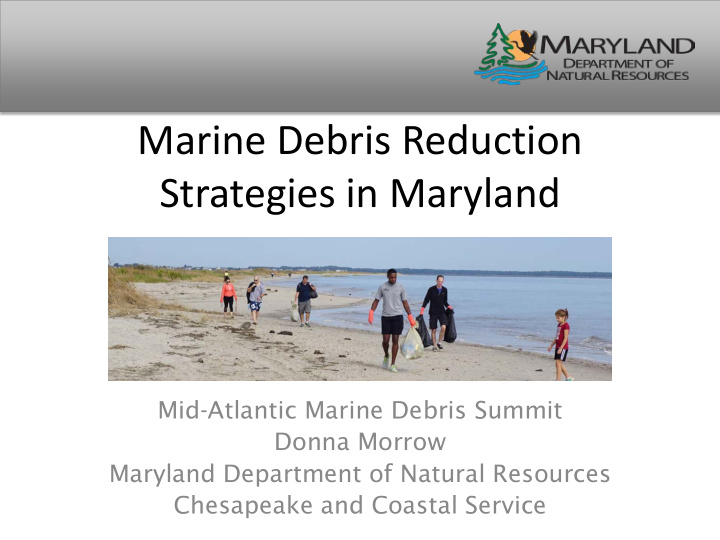



Marine Debris Reduction Strategies in Maryland Mid-Atlantic Marine Debris Summit Donna Morrow Maryland Department of Natural Resources Chesapeake and Coastal Service
Efforts in Maryland • Micro-bead ban (2015) • Polystyrene foam food containers ban (2019) • Keep Maryland Beautiful grants • Maryland Litter Policy • SHA “Adopt a Highway” program • Marine Debris Advisory Team to Coastal Zone Management Program (2019) • Abandoned Boats and Debris program • Shrink Wrap Recycling Project
Abandoned Boat and Debris Program • Reimbursable grants and expertise to assist public agencies in the removal of abandoned boats and debris from state waters. Funded by Maryland’s Waterway Improvement Fund • Only authorized public entities in Maryland with ownership, management or jurisdiction over the aquatic lands where the vessel or hazardous debris is located may apply for grants • $25,000 annual limit per jurisdiction
Maryland’s Waterway Improvement Fund • Funded by boaters via 5% excise fee when boat titled in Maryland • Funds improvements that benefit the boating public such as aids to navigation, dredging, public boat ramps, fire/rescue boats, debris removal, and boating information and education • Established by legislature in 1966 • Since its inception, Waterway Improvement Fund has provided more than $300 million for 4,500 projects at more than 300 public boating access sites
Abandoned Boat Definition “A vessel that has remained at a location without the owner or person in control of the property’s consent: • More than 30 days on public property, including public marinas, docks, or boatyards • More than 30 days at a private dock or near water’s edge on private property • More than 90 days at a private marina or boatyard or property operated by a private marina or boatyard More than 180 days at private property
Vessels Removed 2011 19 2012 22 2013 22 2014 19 2015 16 2016 23 2017 26 2018 27
Debris Removal • Debris that poses a hazard to navigation or limits access to a public boating access facility or a shipping channel is eligible for removal • Grants provided to municipalities • Following severe weather DNR will directly remove debris with our equipment and personnel in addition to l
Shrink Wrap Recycling Approximately 178,000 • recreational boats registered in Maryland Large numbers of boaters • use shrink wrap each winter to protect their boats Not a demonstrated • contributor of marine debris but wasteful and recyclable Copied project model from •
2019 Pilot Shrink Wrap Project • Sell bags for $15 that hold wrap from a medium size boat • Special instructions to remove wrap to be recyclable • Bags collected by Chesapeake Materials for transport and recycling
2019 Pilot Results • 29 Marinas participated • Over 850 boats • Approximately 30,000 pounds of plastic kept from the landfill • Plan to repeat and expand in 2020
Future Direction • Microplastics and marine debris are emerging issues in Chesapeake Bay restoration work • Following current research and data to inform future efforts and funding decisions • Maryland Marine Debris Advisory Team—Advising our Chesapeake and Coastal Service
Donna Morrow Donna.morrow@Maryland.gov Dnr.Maryland.gov/CCS
Recommend
More recommend